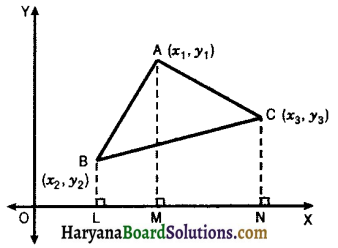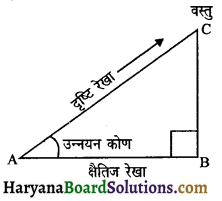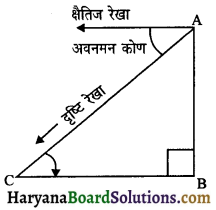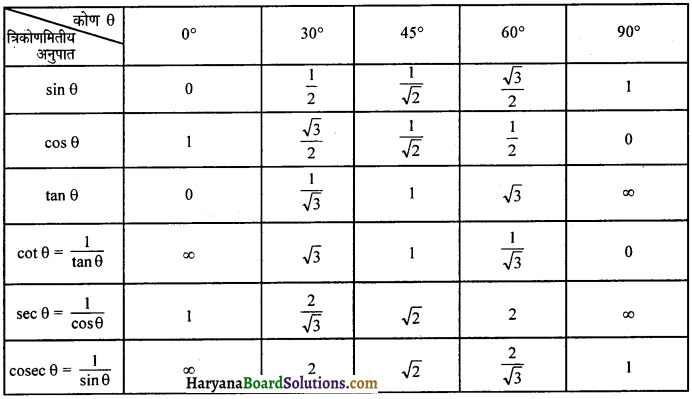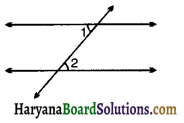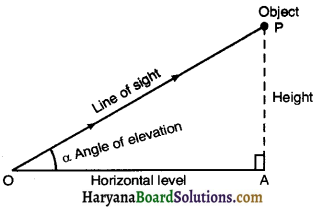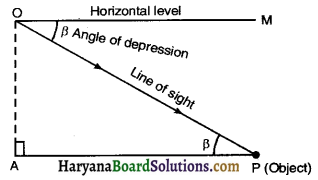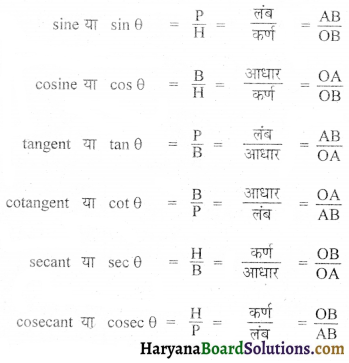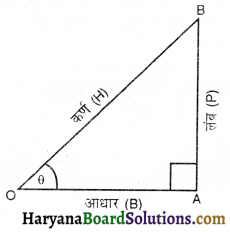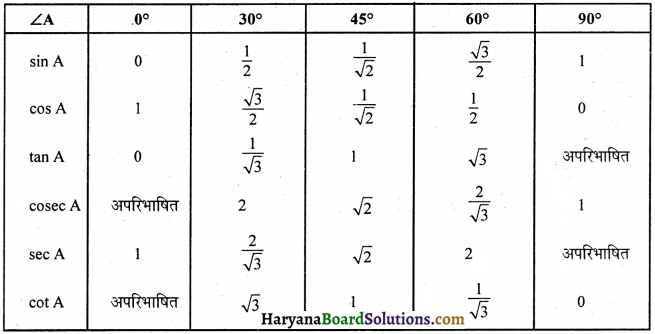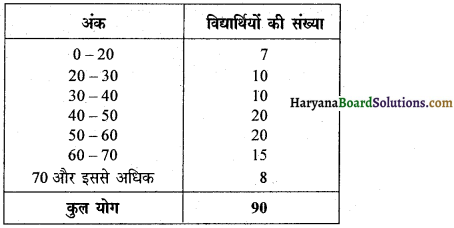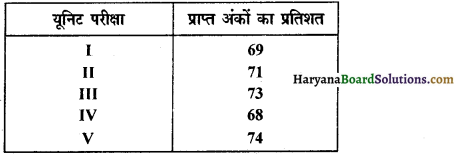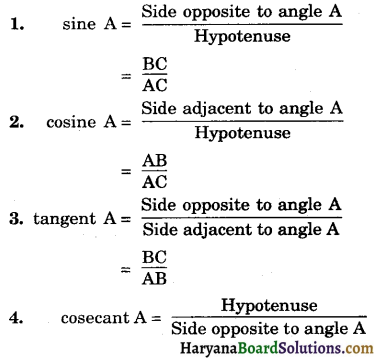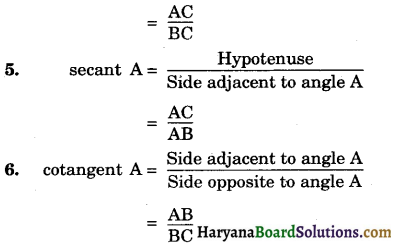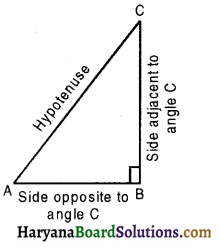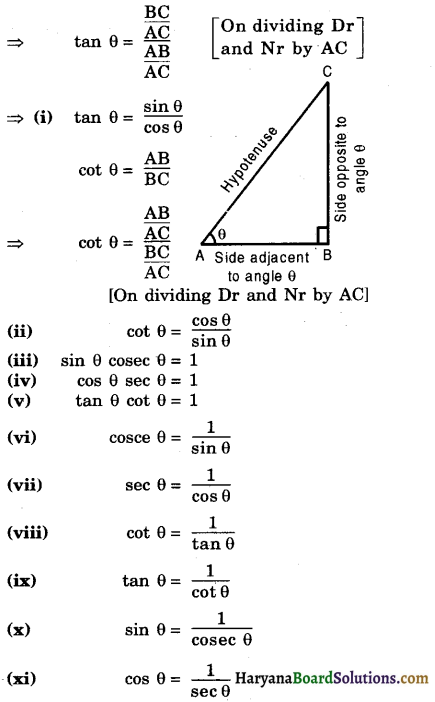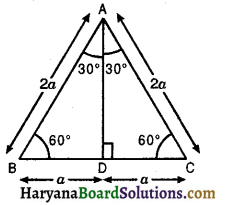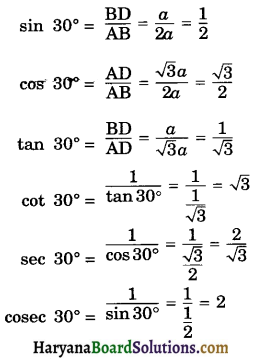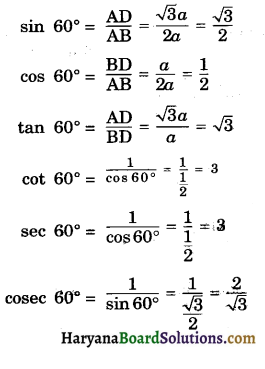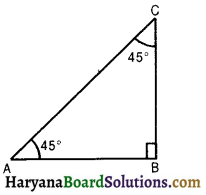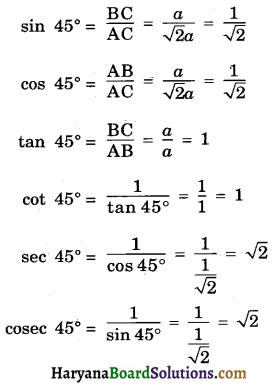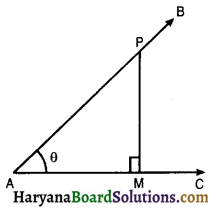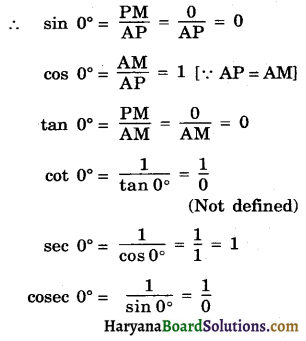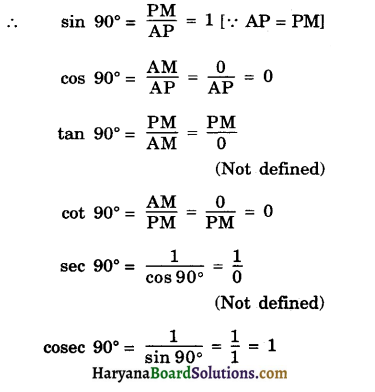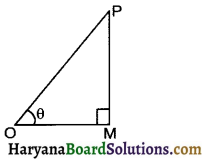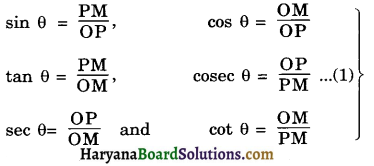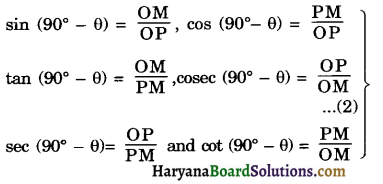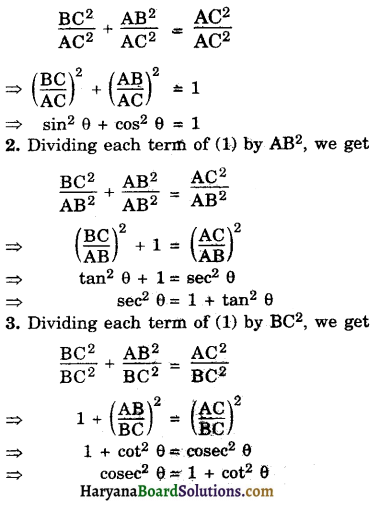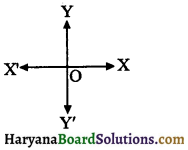Haryana State Board HBSE 9th Class Maths Important Questions Chapter 2 बहुपद Important Questions and Answers.
Haryana Board 9th Class Maths Important Questions Chapter 2 बहुपद
Multiple Choice Questions With Answers:
प्रश्न 1.
निम्नलिखित प्रत्येक बहुपद में का गुणांक लिखिए।
(i) √2 + x – x2
(ii) 5x2 + 3x + 2
हल :
(i) √2 + x – x2 में x2 का गुणांक = – 1
(ii) 5x2 + 3x + 2 में x2 का गुणांक = 5.
प्रश्न 2.
बताइए कि निम्नलिखित दरुपदों में से कौन-कौन से बहुपद रैखिक हैं। कौन-कौन से द्विघाती हैं और कौन-कौन से त्रिघाती हैं-
(i) y2 + 1
(ii) 5x3
(iii) y2 + y + 5
(iv) √2 + x – x2
(v) u + 1
हल :
(i) बहुपद y2 + 1 द्विघाती बहुपद है।
(ii) बहुपद 5x3 एक त्रिघाती बहुपद है।
(iii) बहुपद y2 + y + 5 एक द्विघाती बहुपद है।
(iv) √2 + x – x2 एक द्विघाती बहुपद है।
(v) बहुपद u + 1 एक रैखिक बहुपद है।
प्रश्न 3.
बताइए कि निम्नलिखित बहुपदों में से कौन-कौन से बहुपद एकपदी हैं, कौन-कौन से द्विपदी हैं और कौन-कौन से त्रिपदी हैं
(i) x4 + x + 5
(ii) 5y6 – 4y2 – 6
(iii) x3 – 1
(iv) – 5x2
(v) u4
(vi) u43 – u2
हल :
(i) बहुपद x4 + x + 5 एक त्रिपदी है।
(ii) बहुपद 5y6 – 4y – 6 एक त्रिपदी है।
(iii) बहुपद x3 – 1 एक द्विपदी है।
(iv) बहुपद – 5x2 एक एकपदी है।
(v) बहुपद u4 एक एकपदी है।
(vi) बहुपद u43 – u2 एक द्विपदी है।

प्रश्न 4.
बहुपद p (x) = 4x4 + 5x3 – x2 + 6 के लिए p (0), p (1) तथा p (2) का मान ज्ञात कीजिए।
हल :
यहाँ पर
p (x) = 4x4 + 5x3 – x2 + 6
x = 0 रखने पर
p (0) = 4 (0)4 + 5 (0)3 – (0)2 + 6
= 0 + 0 – 0 + 6
= 6
x = 1 रखने पर
p (1) = 4 (1)4 + 5 (1)3 – (1)2 + 6
= 4 + 5 – 1 + 6
= 15 – 1 = 14
x = 2 रखने पर
p (2) = 4 (2)4 + 5 (2)3 – (2)2 + 6
= 4 × 16 + 5 × 8 – 4 + 6
= 64 + 40 – 4 + 6
= 110 – 4 = 106
प्रश्न 5.
बहुपद p (x) = 2x + 1 का एक शून्यक ज्ञात कीजिए।
हल :
बहुपद का शून्यक ज्ञात करने के लिए आवश्यक है-
p (x) = 0
2x + 1 = 0
2x = 0 – 1
2x = -1
x = – \(\frac{1}{2}\)
अतः – \(\frac{1}{2}\) बहुपद 2x + 1 का एक शून्यक है।
प्रश्न 6.
3x2 + x – 1 को x + 1 से भाग दीजिए।
हल :
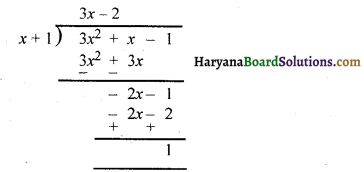
अतः भागफल = 3x – 2; शेषफल = 1

प्रश्न 7.
शेषफल ज्ञात करें जब बहुपद p (x) = 2x4 – 6x3 – 2x2 – x + 2 को x + 2 से भाग किया जाता है।
हल :
यहाँ पर
p (x) = 2x4 – 6x3 – 2x2 – x + 2
x + 2 का शून्यक -2 है।
∴ p(- 2) = 2(- 2)4 – 6 (- 2)3 – 2 (- 2)2 – (- 2) + 2
= 2 (16) – 6 (- 8) – 2 (4) + 2 + 2
= 32 + 48 – 8 + 2 + 2 = 76
अतः p (x) को x + 2 से भाग देने पर शेषफल = 76.
प्रश्न 8.
यदि x – 1, 4x3 + 3x2 – 4x + k का एक गुणनखंड हो, तो k का मान ज्ञात कीजिए।
हल :
क्योंकि x – 1, p (x) = 4x3 + 3x2 – 4x + k का एक गुणनखंड है,
इसलिए
p(1) = 0 होगा।
p (1) = 4 (1)3 + 3 (1)2 – 4 (1) + k
इसलिए 4 + 3 – 4 + k = 0
या k = 3.
प्रश्न 9.
x2 + 14x + 45 का गुणनखंडन कीजिए।
हल:
x2 + 14x + 45 = x2 + 9x + 5x + 45
= x (x + 9) + 5 (x + 9)
= (x + 9) (x + 5).

प्रश्न 10.
द्विघात बहुपद 6x2 + 5x – 6 के गुणनखण्ड ज्ञात कीजिए।
हल :
यहाँ पर
6x2 + 5x – 6 = 6x2 + 9x – 4x – 6
= 3x (2x + 3) – 2 (2x + 3)
= (2x + 3) (3x – 2)
प्रश्न 11.
x3 – 6x2 + 11x – 6 का गुणनखंडन कीजिए।
हल :
माना
p(x) = x3 – 6x2 + 11x – 6
यहाँ पर अचर पद – 6 है जिसके गुणनखंड ± 1, ± 2, ± 3, ± 6 हैं।
x = 1 रखने पर
p(1) = (1)3 – 6 (1)2 + 11 (1) – 6
= 1 – 6 + 11 – 6
= 12 – 12 = 0
अतः x – 1, p (x) का एक गुणनखंड है।
अब
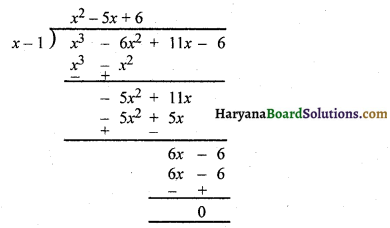
x3 – 6x2 + 11x – 6 = (x – 1) (x2 – 5x + 6)
= (x – 1) (x2 – 3x – 2x + 6)
= (x – 1) [x (x – 3) – 2 (x – 3)]
= (x – 1) (x – 3)(x – 2)

प्रश्न 12.
सीधे गुणा किए बिना 102 × 103 का मान ज्ञात करें।
हल :
102 × 103 = (100 + 2) (100 +3)
= (100)2 + (2 + 3) (100) + 2 × 3
= 10000 + 500 + 6 = 10506.
प्रश्न 13.
p4 – 625 का गुणनखंडन कीजिए।
हल:
p4 – 625 = (p2)2 – (25)2
= (p2 – 25) (p2 + 25)
= [(p)2 – (5)] (p2 + 25)
= (p – 5) (p + 5) (p2 + 25).
प्रश्न 14.
उपयुक्त सर्वसमिका का प्रयोग करके 105 × 106 का मान ज्ञात कीजिए।
हल :
105 × 106 = (100 + 5) (100 +6)
= (100)2 + (5 + 6) × 100 + 5 × 6
= 10000 + 11 × 100 + 30
10000 + 1100 + 30
= 11130.
प्रश्न 15.
8x3 + y3 + 27z3 – 18xyz का गुणनखण्ड कीजिए।
हल :
हम जानते हैं कि a3 + b3 + c3 – 3abc = (a + b + c) (a2 + b2 + c2 – ab – bc – ca)
8x3 + y3 + 27z3 – 18xyz = (2x)3 + (y)3 + (3z)3 – 3 (2x) (y) (z)
(2x + y + 3z) [(2x)2 + (y)2 + (3z)2 – (2x) (y) – (y) (3z) – (3z) (2x)]
(2x + y + 3z) [4x2 + y2 + 9z2 – 2xy – 3yz – 6zx]

Multiple Choice Questions With Answers:
प्रश्न 1.
बहुपद x5 – x4 + 3 की घात है-
(A) शून्य
(B) 3
(C) 4
(D) 5
उत्तर-
(D) 5
प्रश्न 2.
बहुपद 2 – x2 – x3 + 2x8 की घात होगी-
(A) 2
(B) 3
(C) शून्य
(D) 8
उत्तर-
(D) 8
प्रश्न 3.
निम्नलिखित बीजीय व्यंजकों में कौन-सा एक बहुपद है ?
(A) x2 + 5x + 6
(B) y + \(\frac{1}{2 y}\)
(C) 5t + 3
(D) \(\frac{1}{5 x+3}\)
उत्तर-
(A) x2 + 5x + 6

प्रश्न 4.
निम्नलिखित वीजीय व्यंजकों में से कौन-सा व्यंजक बहुपद नहीं है ?
(A) x10 + 3x3 + 5x50
(B) y2 + √2
(C) 4y2 – 3y + 7
(D) y + \(\frac{2}{2y}\)
उत्तर-
(D) y + \(\frac{2}{2y}\)
प्रश्न 5.
निम्नलिखित में से कौन-सा व्यंजक एक चर वाला है ?
(A) 4x2 – 3x + 7
(B) x10 + y3 – t5
(C) 4x2 – 3y + 7
(D) 4x2 – 3y + 7z
उत्तर-
(A) 4x2 – 3x + 7
प्रश्न 6.
निम्नलिखित में से कौन-सा व्यंजक दो चर वाला है ?
(A) 4x2 – 3x + 7
(B) x10 + y3 – 150
(C) 4x2 – 3y + 7
(D) 4x2 – 3y + 7z
उत्तर-
(C) 4x2 – 3y + 7.

प्रश्न 7.
\(\frac{\pi}{2}\) x2 + x में :’ का गुणांक है-
(A) 1
(B) π
(C) \(\frac{1}{2}\)
(D) \(\frac{\pi}{2}\)
उत्तर-
(D) \(\frac{\pi}{2}\)
प्रश्न 8.
√2x – 1 में x2 का गुणांक है-
(A) शून्य
(B) 1
(C) √2
(D) – 1
उत्तर-
(A) शून्य
प्रश्न 9.
निम्नलिखित बहुपदों में से कौन-सा बहुपद द्विघाती नहीं है ?
(A) x2 + x
(B) x – x3
(C) y + y2 + 4
(D) r2
उत्तर-
(B) x – x3
प्रश्न 10.
निम्नलिखित बहुपदों में से कौन-सा बहुपद रैखिक है ?
(A) x2 + x
(B) y + 4
(C) 3t – t3
(D) 7
उत्तर-
(B) y + 4

प्रश्न 11.
निम्नलिखित बहुपदों में से कौन-सा बहुपद त्रिघाती है ?
(A) 1 + x
(B) y + y2 + 4
(C) x – x3
(D) y2 + y
उत्तर-
(C) x – x3
प्रश्न 12.
x = 1 पर बहुपद p(x) = 5x2 – 3x + 7 का मान होगा-
(A) 8
(B) 15
(C) 9
(D) 1
उत्तर-
(C) 9
प्रश्न 13.
बहुपद p(x) = 2x + 1 का एक शून्यक होगा
(A) \(\frac{1}{2}\)
(B) – \(\frac{1}{2}\)
(C) 2
(D) – 2
उत्तर-
(B) – \(\frac{1}{2}\)
प्रश्न 14.
x = – 1 पर बहुपद 5x – 4x2 + 3 का मान होगा-
(A) 6
(B) 4
(C) 6
(D) – 4
उत्तर-
(A) 6

प्रश्न 15.
बहुपद p(x) = (x – 1) (x + 1) के लिए p(0) का मान होगा-
(A) – 1
(B) 1
(C) 0
(D) 3
उत्तर-
(A) – 1
प्रश्न 16.
बहुपद p(y) = y2 – y + 1 के लिए p(0) का मान होगा-
(A) 1
(B) – 1
(C) 2
(D) – 2
उत्तर-
(A)1
प्रश्न 17.
बहुपद p(x) = 2x + 5 का शून्यक होगा-
(A) \(\frac{5}{2}\)
(B) – \(\frac{5}{2}\)
(C) \(\frac{2}{5}\)
(D) – \(\frac{2}{5}\)
उत्तर-
(B) – \(\frac{5}{2}\)
प्रश्न 18.
बहुपद p(x) = cx + d; {c’ 0, c, d वास्तविक संख्याएँ हैं} में बहुपद का शून्यक होगा-
(A) \(\frac{d}{c}\)
(B) – \(\frac{d}{c}\)
(C) \(\frac{c}{d}\)
(D) – \(\frac{c}{d}\)
उत्तर-
(B) – \(\frac{d}{c}\)

प्रश्न 19.
बहुपद P(y) = 3y में बहुपद का शून्यक होगा-
(A) शून्य
(B) 1
(C) 3
(D) – 3
उत्तर-
(A) शून्य
प्रश्न 20.
3x2 + x – 1 को x + 1 से भाग देने पर शेषफल प्राप्त होगा-
(A) 1
(B) – 1
(C) – 2
(D) 2
उत्तर-
(A) 1
प्रश्न 21.
3x4 + – 4x3 – 3x – 1 को x – 1 से भाग करने पर शेषफल प्राप्त होगा-
(A) 5
(B) – 5
(C) शून्य
(D) – 3
उत्तर-
(B) – 5
प्रश्न 22.
p(x) = x3 +3x2 + 3x + 1 को x + π से भाग देने पर शेषफल प्राप्त होगा-
(A) – π3 + 3π2 – 3π + 1
(B) π3 + 3π2 – 3π + 1
(C) π3 + 3π2 + 3π + 1
(D) – π3 – 3π2 + 3π + 1
उत्तर-
(A) – π3 + 3π2 – 3π + 1

प्रश्न 23.
x3 + 3x2 + 3x + 1 को x + 1 से भाग देने पर शेषफल प्राप्त होगा-
(A) – 1
(B) 1
(C) शून्य
(D) 2
उत्तर-
(C) शून्य
प्रश्न 24.
p(x) = x3 – ax2 + 6x – 4 को x – a से भाग देने पर शेषफल प्राप्त होगा-
(A) – 5a
(B) 5a
(C) 7a
(D) – 7a
उत्तर-
(B) 5a
प्रश्न 25.
p(y) = y3 + 3y2 + 3y + 1 को y से भाग करने पर शेषफल प्राप्त होगा-
(A) शून्य
(B) – 1
(C) 1
(D) 2
उत्तर-
(C) 1.
प्रश्न 26.
यदि p(x) = x2 + x + k का एक गुणनखंड (x-1) हो तो k का मान होगा-
(A) 2
(B) – 2
(C) 1
(D) – 1
उत्तर-
(B) – 2

प्रश्न 27.
y2 – 5y + 6 का गुणनखंडन होगा-
(A) (y – 2) (y – 3)
(B) (y – 2) (y + 3)
(C) (y + 2) (y – 3)
(D) (y + 2) (y +3)
उत्तर-
(A) (y – 2) (y – 3)
प्रश्न 28.
2x2 + 7x + 3 का गुणनखंडन होगा-
(A) (x – 3) (2x + 1)
(B) (x + 3) (2x + 1)
(C) (x + 3) (2x – 1)
(D) (x -3) (2x – 1)
उत्तर-
(B) (x + 3) (2x + 1)
प्रश्न 29.
उपयुक्त सर्वसमिका के उपयोग से (x + 4) (x + 10) का गुणनफल होगा-
(A) x2 + 6x + 40
(B) x2 + 14x + 40
(C) x2 + 14x – 40
(D) x2 + 14x – 40
उत्तर-
(B) x2 + 14x + 40
प्रश्न 30.
उपयुक्त सर्वसमिका के उपयोग से (3x + 4) (3x – 5) का गुणनफल होगा-
(A) 9x2 – 3x – 20
(B) 9x2 + 3x + 20
(C) 9x2 – 3x + 20
(D) 9x2 + 3x – 20
उत्तर-
(A) 9x2 – 3x – 20

प्रश्न 31.
104 × 96 का मान ज्ञात करने के लिए उपयुक्त है-
(A) (100 + 4) (90 + 6)
(B) (110 – 6) (90 + 6)
(C) (100 + 4) (100 – 4)
(D) (110 – 6) (100 – 4)
उत्तर-
(C) (100 + 4) (100 – 4)
प्रश्न 32.
(x + 3) (x + 3) = x2 + ……………….. + 9 के रिक्त स्थान पर होगा-
(A) 2x
(B) 3x
(C) 6x
(D) 5x
उत्तर-
(C) 6x
प्रश्न 33.
(3 + 2x) (3 – 2x) का मान होगा-
(A) 9 + 4x2
(B) 9 – 42
(C) 9 – 2x2
(D) 9 + 2x2
उत्तर-
(B) 9 – 4x2
प्रश्न 34.
9x2 + 6xy + y2 का गुणनखंडन होगा-
(A) (3x+ y) (3x + y)
(B) (3x – y) (3x – y)
(C) (3x + y) (3x–2)
(D) इनमें से कोई नहीं
उत्तर-
(A) (3x +y) (3x + y)

प्रश्न 35.
उपयुक्त सर्वसमिका का प्रयोग करके \(x^2-\frac{y^2}{100}\) का गुणनखंडन होगा
(A) \(\left(x-\frac{y}{10}\right)\left(x-\frac{y}{10}\right)\)
(B) \(\left(x+\frac{y}{10}\right)\left(x-\frac{y}{10}\right)\)
(C) \(\left(x+\frac{y}{10}\right)\left(x+\frac{y}{10}\right)\)
(D) इनमें से कोई नहीं
उत्तर-
(B) \(\left(x+\frac{y}{10}\right)\left(x-\frac{y}{10}\right)\)
प्रश्न 36.
उपयुक्त सर्वसमिका का प्रयोग करके 49a2 + 70ab + 25b2 का गुणनखंडन होगा-
(A) (7a + 5b) (7a + 5b)
(B) (7a-5b) (7a-5b)
(C) (7a + 5b) (7a-5b)
(D) इनमें से कोई नहीं
उत्तर-
(A) (7a + 5 b) (7a + 5b)
प्रश्न 37.
उपयुक्त सर्वसमिका का प्रयोग करके 4y2 – 4y + 1 का गुणनखंडन होगा-
(A) (2y + 1) (2y + 1)
(B) (2y – 1) (2y – 1)
(C) (2y – 1) (2y + 1)
(D) इनमें से कोई नहीं
उत्तर-
(B) (2y – 1) (2y – 1)
प्रश्न 38.
(- 2x + 5y – 3z)2 का प्रसारित रूप होगा-
(A) – 4x2 + 25y2 – 9z2 – 20xy – 30yz + 12xz
(B) – 4x2 + 25y2 + 9z2 + 20xy + 30yz + 12xz
(C) – 4x2 + 25y2 – 9z2 + 20xy + 30yz + 12xz
(D) 4x2 + 25y2 + 922 – 20xy – 30yz + 12xz
उत्तर-
(D) 4x2 + 25y2 + 9z2 – 20xy – 30yz + 12xz

प्रश्न 39.
(104) को सरल करने के लिए उपयुक्त सर्वसमिका है-
(A) (100 + 4)3
(B) (110 – 6)3
(C) (90 + 14)3
(D) (120 – 16)3
उत्तर-
(A) (100 + 4)3
प्रश्न 40.
(5p – 3q)3 का प्रसारित रूप होगा-
(A) 125p3 – 27q3 – 225pq2 – 135pq2
(B) 125p3 — 27q3 – 225p2q + 135pq2
(C) 125p3 + 27q3 + 225p2q + 135pq2
(D) 125p3 – 27q3 + 225p2q + 135pq2
उत्तर-
(B) 125p3 — 27q3 – 225p2q + 135pq2
प्रश्न 41.
(2x + 1)3 का प्रसारित रूप होगा-
(A) 8x3 + 12x2 + 6x + 1
(B) 8x3 + 12x2 + 6x – 1
(C) 8x3 – 12x2 + 6x – 1
(D) 8x3 – 12x2 – 6x – 1
उत्तर-
(A) 8x3 + 12x2 + 6x + 1
प्रश्न 42.
निम्नलिखित में से कौन-सी सर्वसमिका सत्य है ?
(A) x3 + y3 = (x + y) (x2 + xy + y2)
(B) x3 + y3 = (x + y) (x2 – xy + y2)
(C) x3 – y3 = (x – y) (x2 – xy + y2)
(D) x3 – y3 = (x + y) (x2 – xy + y2)
उत्तर-
(B) x3 + y3 = (x + y) (x2 – xy + y2)

प्रश्न 43.
64m3 – 343n3 का गुणनखंडन करने पर प्राप्त होगा-
(A) (4m – 7n) (16m2 + 49n2 – 28mn)
(B) (4m + 7n) (16m2 + 49n2 – 28mn)
(C) (4m – 7n) (16m2 + 49n2 + 28mn)
(D) (4m + 7n) (16m2 + 49n2 + 28mn)
उत्तर-
(C) (4m – 7n) (16m2 + 49n2 + 28mn)
प्रश्न 44.
यदि x + y + z = 0 हो तो निम्नलिखित में से कौन-सा कथन सत्य है ?
(A) x3 – y3 – z3 = 3xyz
(B) x3 + y3 + z3 = 3xyz
(C) x3 – y3 + z3 = 3xyz
(D) x3 + y3 + z3 = – 3xyz
उत्तर-
(B) x3 + y3 + z3 = 3xyz
प्रश्न 45.
यदि किसी आयत का क्षेत्रफल 25a2 – 35a + 12 हो तो उसकी लंबाई व चौड़ाई क्रमशः होगी-
(A) (5a – 3) व (5a – 4)
(B) (5a + 3) व (5a – 4)
(C) (5a + 3) व (5a + 4)
(D) (5a – 3) व (5a + 4)
उत्तर-
(A) (5a – 3) व (5a – 4)
प्रश्न 46.
यदि किसी घनाभ का आयतन 12ky2 + 8ky – 206 हो तो उसकी संभावित विमाएँ होंगी-
(A) 4k, 3y – 5 व y – 1
(B) 4k, 3y + 5 व y – 1
(C) 4k, 3y + 5 व y + 1
(D) 4k, 3y – 5 व y + 1
उत्तर-
(B) 4k, 3y + 5 व y – 1

प्रश्न 47.
यदि किसी घनाभ का आयतन 3x2 – 12x हो तो उसकी संभावित विमाएँ होंगी-
(A) 4, x और x + 3
(B) 3, x और x + 4
(C) 4, x और x – 3
(D) 3, x और x – 4
उत्तर-
(D) 3, x और x – 4
प्रश्न 48.
बहुपद 2 – x2 – x3 + 5x7 की घात होगी-
(A) 2
(B) 3
(C) 7
(D) 5
उत्तर-
(C) 7
![]()
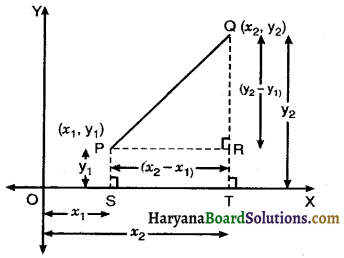

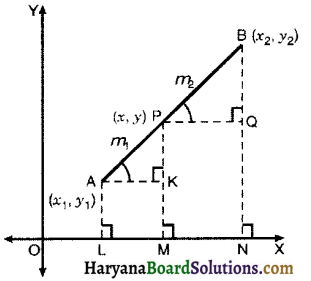
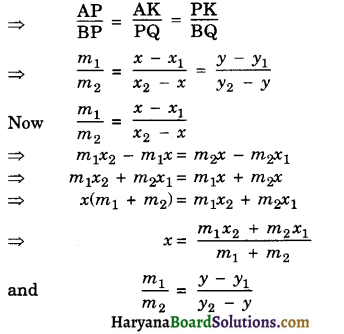
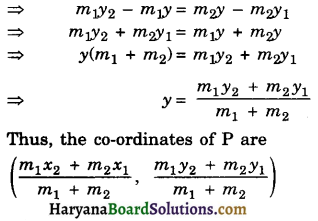
![]()
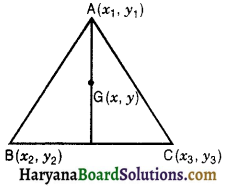
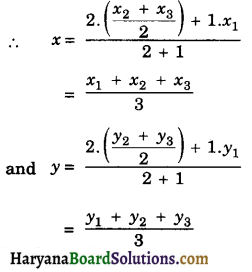
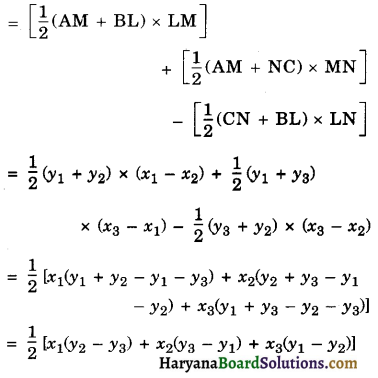
![]()
